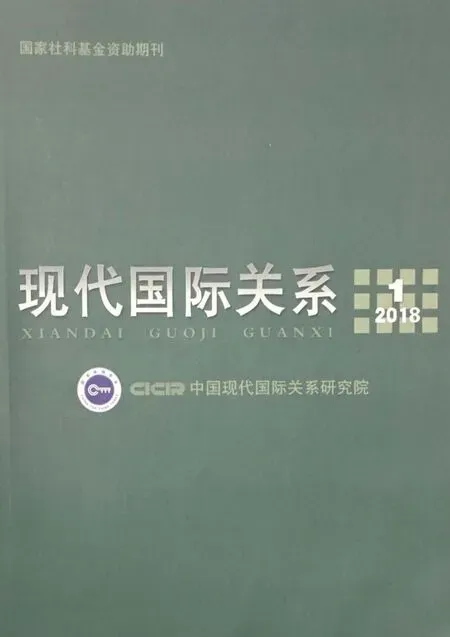Abstracts
GlobalUnprecedentedTransition
ResearchGroupofInstituteofWorldPoliticalStudies,CICIR
Abstract: The year 2017 is the 10th anniversary of the subprime crisis and 100th anniversary of Great October Revolution. China held the 19th National Congress of the Communist Party of China in 2017. The world is undergoing development, reform, and transition. World economy is recovering while structural issues are unresolved in the past decade. Against the backdrop of progressive multilateralism, international security risks are increasing. Social disarray and transition risks are more obvious. Global governance aganda is driven forward in difficulty and multilateral governance system is in urgent need of escalation.
World Politics, Adjustment, Global Structure, Global Governance
MajorCountryDiplomacywithChineseCharacteristicsisMovingForward
ResearchGroupofInstituteofWorldPoliticalStudies,CICIR
Abstract: Since the 18th National Congress of the Communist Party of China, Chinese diplomacy has opened up more fields and achieved significant fruits in vision, strategy and practice. China has established a stable and balanced major power relationship in 2017. Active management of neighborhood diplomacy and resolution of regional tensions accentuate China’s image of being a responsible power. Facing many countries’ reluctance of participation in global affairs and dysfunctional multilateral mechanism, China hosted and participates in summits, encountered serious global challenges, forged consensus of world peace and common development. The 19th National Congress of the Communist Party of China attracts unprecedented international attention. Chinese diplomacy will continue to build a sound external environment for China.
Keywords: Chinese Diplomacy, Major Power Relationship, Global Governance
Japan’sIndo-PacificStrategyandChina’sResponse
WuHuaizhong
Abstract: Japan’s Indo-Pacific strategy started with Abe’s declaration of the Indo-Pacific Strategy for Freedom and Openness. The strategy has three main objectives: to maintain Western-led international rules and regional order; to ensure Japan’s economical interests and to hedge China’s Belt and Road Initiative; and to safeguard the order of the oceans and the free movement through marine routes, restricting China’s strength expansion. The implementation approach is based on bilateral and multilateral cooperation between Japan, US, Australia and India as platforms for the comprehensive utilization of political, economic and security measures in various fields. The attitude of Japan is more prominent in the four countries, while Japan still faces challenges and uncertainties in promoting the strategy.
Keywords: Japan, Indo-Pacific, Geostrategic Strategy, US, Australia, India, Sino-Japanese relations
AnalysisonIndo-PacificStrategyofTrumpAdministration
XiaLipingandZhongQi
Abstract: The Trump Administration put forward Indo-Pacific Strategy in order to deal with the changing world, and to maintain regional strategic balance benefit for the US. The major characteristics of the Indo-Pacific Strategy include to strengthen the alliances and partnership in Indo-Pacific region under the guidance of “Principled Realism” and “America First” National Security Strategy of the US, so as to connect the Indian Ocean with the Pacific Ocean and form the crescent allies and partners network; to use the offshore checks and balances to establish security cooperation mechanism of the US, Japan, Australia, and India; to build up economic relations in the Indo-Pacific region which benefit the US. There are some inner contradictions in Indo-Pacific Strategy of the Trump Administration. The Strategy will further increase the complexity and competitiveness of China-US relations. It will send wrong signals to US allies and partners, Japan will make use of Indo-Pacific Strategy to strengthen its military forces and to expand its spheres of seapower influence.
Keywords: US military and diplomatic affairs, the Indo-Pacific Strategy, Trump Administration, National Security Strategy Report
IndiaandIndo-PacificStrategy:Perception,ParticipationandLimitation
YangRuiandWangShida
Abstract: The US Trump administration has officially launched the Indo-Pacific Strategy in 2017, not only replaced Asia-Pacific by Indo-Pacific in official documents, but also took various actions to realize the Indo-Pacific Dream. Indo-Pacific Strategy highlights the significant adjustment of the regional policy of United States. As one of the leading powers in Indian Ocean Region, India has been regarded as the key to the success of Indo-Pacific Strategy. Both Indian government and the strategic thinkers have actively supported the upgrades of the Indo-Pacific from an academic concept to a foreign strategy of the United States and firmly believed that India would benefit strategically from it. It is estimated that the Indian government will constantly adjust its diplomatic policy, positively cooperate with or even guide the future trend of the Indo-Pacific Strategy so as to compete effectively with the Belt and Road Initiative, counterbalance the rise of China together with the US and eventually realize the Dream of a Great India. However, the strategy is yet to be finanlized and not completely favorable to India. In the future, India should remain cautious, take full advantage of the strategy while avoid confronting with China.
Keywords: India, Indo-Pacific Strategy, intervention, limitation

